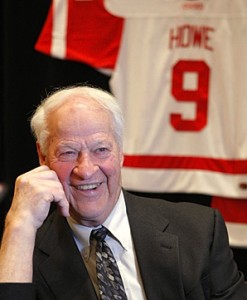Hockey Stats Are Changing
Hockey fans love to debate with other fans about which players are better, and stats are often the center of the argument. Over the past five years, the hockey stats community has been turned on its head by the advanced stats movement. Corsi, Fenwick, PDO, and other numbers are changing the way that people compare NHL players.
Over the past few years, another hockey stats movement has occurred within the history of hockey community. A number of new metrics have been introduced that have changed the way that fans compare players of the past. Here are the most commonly accepted methods of comparing the scoring exploits of players throughout hockey’s history, in an increasing order of sophistication and accuracy:
Raw Point Totals & Raw Points-Per-Game
Comparing point totals on a season by season basis, and career basis is the most simple way to compare players. It is also the most commonly used, and worst method. It is effective when comparing players that played head to head during the same time period because they are subject to the same training, technology, rules, and league trends.
There are two main limitations to this approach. The first is that it fails to take into account games played. Many Flyers fans pointed to the fact that Claude Giroux was the highest

scoring Canadian player of the last three years when he was omitted from Team Canada. That number is flawed because Giroux has been remarkably healthy during that time, missing just five games. Sidney Crosby obviously would have put up more points than Giroux in that span had he been healthy. This method punishes players who deal with injury issues. In addition, the NHL schedule has been in constant evolution since its creation in the early 20th century. In its first season in 1917-18, the season consisted of just 22 games. Since then, that number has consistently risen to 82 today. They even played 84 games a season in 92-93 and 93-94. Comparing players who played in 50 games in the original six era (pre-1967) to players who played 82 games a year makes no sense.
[su_pullquote]”Unless the two players played the bulk of their careers during the same era, an analysis of raw point totals is likely to be flawed.”[/su_pullquote]
The second problem is that it fails to account for the wild differences in scoring levels in different eras. Going by raw point totals, when Dennis Maruk put up 136 points in 1981-82, it was better than Gordie Howe’s best season ever, 1968-69 when he managed 103 points. That certainly does not pass the smell test, and is not correct. When Maruk put up those totals, scoring, and as a result point totals, were significant higher than when Howe played hockey. The average number of goals in a game in 1981-82 was 8.03, much higher than the 5.96 in 1968-69. In general, scoring levels were lower in the early years, and saw a significant increase when the league expanded from six teams to twelve. It peaked during the 1980s and early 1990s. When the Dead Puck Era hit in the mid 1990s, scoring went down significantly and it has been increasing at a snail’s pace to this day, despite some of the NHL’s efforts to speed it up.
Unless the two players played the bulk of their careers during the same era, an analysis of raw point totals is likely to be flawed and can result in incorrect conclusions. Ron Francis has the fourth most points in NHL history, but he certainly is not the fourth most prolific point scorer in NHL history.
Using points-per-game eliminates the first problem because it only shows what the player did on a per-game basis. But, NHL player comparison still has the big problem of not accounting for the level of scoring in the league. It is a slight improvement, but far from the best method.
Rankings
This method is effective because it is universal across all eras. A first place finish is a first place finish. But like raw points, it has major drawbacks that make it significant only in comparisons for players that played head to head. The first is that it is an arbitrary number, and does not provide any context to the point totals. It does not take into account that every fourth place finish in points is not equal. For example, in 1935-36, there was a five way tie for fourth place in points with 38. The league leader had 45, a difference of 18.42%. But in 1982-83, fourth place Mike Bossy had 118 points compared to first place Wayne Gretzky’s 196, a difference of 66%. Rankings just give a number, but do not show how much better or worse a player was compared to his peers that season.
If you wanted to compare Evgeni Malkin and Steven Stamkos, then comparing their points rankings would be a legitimate way to look at them. But if you’re comparing the merits of original six star Howie Morenz to Phil Esposito, using rankings would not be the correct way to go about it.
Adjusted Points and Adjusted Points-Per-Game
Coming from the database Hockey Reference, adjusted points is the next step up in hockey statistics. It improves by eliminating the problem of wildly different scoring levels between different eras. It does this by normalizing schedule size, roster size, and average goals/assists per game in a year. In years where scoring was very high like the 1980s, adjusted point totals are significantly lower than their raw totals. In lower scoring eras like the Dead Puck Era in the late 1990s and early 2000s, point totals are boosted.
Adjusted point totals can be found on an individual’s Hockey Reference page under the table that shows their raw scoring stats. For example, here are Wayne Gretzky’s numbers. Notice that despite the fact that he had multiple 200 point seasons, his highest adjusted point total is 170.
| Adjusted | ||||
|---|---|---|---|---|
| Season ▴ | Tm | G | A | PTS |
| 1979-80 | EDM | 43 | 74 | 117 |
| 1980-81 | EDM | 42 | 85 | 127 |
| 1981-82 | EDM | 68 | 88 | 156 |
| 1982-83 | EDM | 57 | 102 | 159 |
| 1983-84 | EDM | 69 | 94 | 163 |
| 1984-85 | EDM | 58 | 108 | 166 |
| 1985-86 | EDM | 41 | 129 | 170 |
| 1986-87 | EDM | 52 | 103 | 155 |
| 1987-88 | EDM | 33 | 91 | 124 |
| 1988-89 | LAK | 45 | 94 | 139 |
| 1989-90 | LAK | 34 | 86 | 120 |
| 1990-91 | LAK | 37 | 109 | 146 |
| 1991-92 | LAK | 28 | 80 | 108 |
| 1992-93 | LAK | 13 | 39 | 52 |
| 1993-94 | LAK | 35 | 84 | 119 |
| 1994-95 | LAK | 19 | 64 | 83 |
| 1995-96 | TOT | 22 | 75 | 97 |
| 1996-97 | NYR | 26 | 75 | 101 |
| 1997-98 | NYR | 26 | 77 | 103 |
| 1998-99 | NYR | 10 | 60 | 70 |
| Career | 758 | 1717 | 2475 | |
| Career | ||||
Going back to our earlier example of Gordie Howe and Dennis Maruk, according to adjusted points Howe’s total would be 101, and Maruk’s 100. This result is much more logical. Maruk had a remarkable career year that he failed to come close to matching again, and that is Howe’s seventh best season in terms of adjusted points.
Adjusted points-per-game is used to compare players across eras who may have had injury issues. To calculate it, it does require an upward adjustment to the total games played for players that played in earlier eras with shorter schedules because Hockey Reference calculates adjusted points based on an 82 game season.
In general, adjusted points is a good tool to compare players across eras that does not require much work. The only drawback is that because it is purely formula based, it produces [su_pullquote]Was Cooney Weiland as dominant as Wayne Gretzky?[/su_pullquote]some results that do not pass the smell test. For example, it gives Cooney Weiland 168 adjusted points in 1929-30, which is more than all but one of Gretzky’s seasons of adjusted points. Gretzky was clearly more dominant than Weiland in more than one season. This result is created due to an explosion of scoring in 1929-30 when the forward pass was first allowed in the offensive zone in the NHL. In certain isolated seasons, it produces weird results that cannot be taken at face value. It also deflates 1980s scorers a bit more than it should.

VsX Method
By far the most accurate (and little known) method for comparing scorers across eras is the VsX method. It originated on HFBoards on the History of Hockey and All-Time Draft board (on which I’m an active poster). A complete discussion of it can be found here. It is calculated by taking a player’s point total in a certain year, and dividing it by a benchmark number of one of the league’s leading scorers. Unless there is a statistical anomaly, the second highest point scorer in that year is used as the benchmark. This is done because using the number one scorer, who is usually well ahead of the pack, deflates the numbers of everyone behind him, not allowing us to see the true differences between the rest of the field.
Let’s continue with our Howe and Maruk example. In 1968-69, the benchmark is second place scorer Bobby Hull, who had 107 points. To get Howe’s “score” for the year, simply divide 103/107, and you get 96.26. For Maruk, the benchmark is second place scorer Mike Bossy, who had 147 points. Maruk’s score is, then, 136/147=92.52. This means that Howe’s season was 3.74% more impressive than Maruk’s. According to VsX, Howe has thirteen seasons better than Maruk’s best of 92.52, despite never having a raw point total higher than Maruk’s.

Using this method provides important context to the numbers. It shows exactly how much better or worse a player was compared to his peers, instead of assigning an arbitrary rank. The criteria for the benchmarks has been changed to produce results that are logical, and pass the smell test. It is not a single, solitary formula that creates problems seasons like adjusted points. Using VsX allows you to effectively compare the offense of players across any era. It can be used on a season-by-season basis to see what player has a higher peak, or summed up and averaged to show a player’s career value as an offensive contributor.
If you use the VsX method, you will be considered a highly advanced and educated member of the hockey stats community.